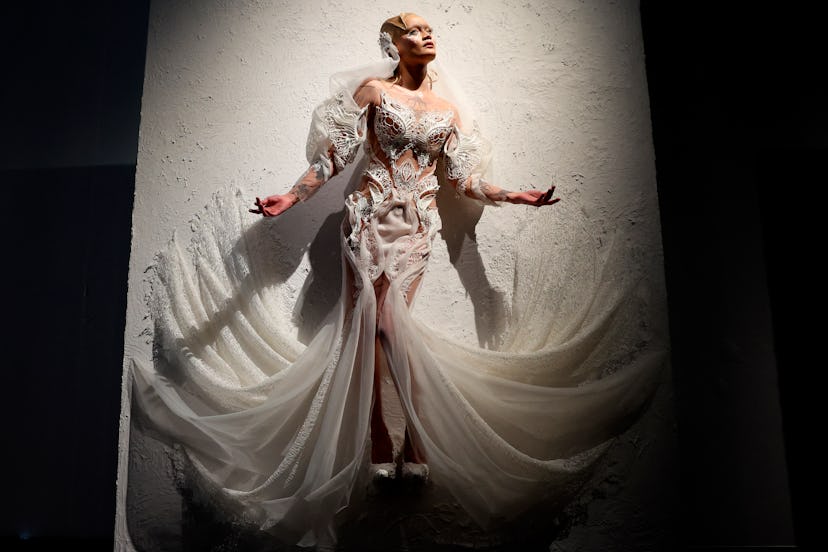Whether through 3D printing or mechanized garments, Iris van Herpen has accelerated technology’s integration into high fashion. While the Dutch couturier—known for her ethereal, kinetic creations—has always been ahead of the curve, she’s learned the value in pumping the brakes. “After doing runway shows for 17 years, I noticed that the speed was actually slowing me down. There’s no time to explore a new chapter,” van Herpen tells W. Although the designer has focused on couture since establishing her label in 2007, her frequent collaborations with architects, choreographers, scientists, and artists—all of which were highlighted in her 2023-24 Musée des Arts Décoratifs blockbuster exhibition, “Iris van Herpen: Sculpting the Senses”—have made her question her own creative predilections.
“I’ve always seen myself as an interdisciplinary artist,” says van Herpen, who in addition to her classical dance training, grew up painting and sculpting “all the time.” The latter is what drew her to study at ArtEZ University of the Arts in Arnhem, where she was exposed to a range of media before landing on fashion design. Having increasingly yearned to return to her first love, van Herpen opted out of spring 2024 Haute Couture Week this past January to give her mind room to breathe and wander.
On June 24 in Paris, van Herpen returned to the Haute Couture Week calendar, but this time, with a pared-down collection of five couture looks, presented in a 45-minute performance alongside her first aerial artworks. Conceived as “off-body sculptures” suspended by steel tubes, the large-scale pieces showcased a variety of her masterful hand techniques, yet felt distinctly more visceral and free. “There is a sense of couture in the sculpture, though it’s fully transformed,” says van Herpen.
Coco Rocha performs at Iris van Herpen’s couture show in Paris.
Backstage at the show.
Van Herpen has, too, been transformed by the process of making these artworks. She attributes much of their meaning to her reconnection with nature. Two years ago, she and her partner Salvador Breed, who composes the soundscapes for van Herpen’s shows, moved 30 minutes north of Amsterdam to a rural home, where tending to the wild garden and visiting the neighboring bird sanctuary have become the couturier’s preferred pastimes. “If you asked me 10 years ago if I’d be gardening, I would have laughed at you,” says van Herpen, who lived in the city center for 15 years. “We change, and that’s a good thing.”
Van Herpen’s fall 2024 couture “Hybrid” presentation-meets-installation powerfully embodies the designer’s reverence for nature, both as an eternal muse and a vital source of life. The sculpture Ancient Ancestors, for example—algae-like in composition with coral-like 3D-printed structures dusted in sand—encapsulates van Herpen’s connection to water and the origin of our senses. (According to the couturier, recent scientific research has proven that 700 million years ago, the first marine organisms developed their sensorial capabilities in response to the movement of the sea.)
Unfolding Time, a sculpture composed of spiraling pleated silk curves, captures van Herpen’s perception of time being stretched when she is outdoors. It also symbolizes how cyclical rhythms within nature, such as the seasonal changes she observes in her garden, can parallel the creative process. “It’s about slowing time to become more conscious of what’s going on internally,” says van Herpen. “When I’m working on these sculptures, there’s a cosmos of opportunities with how many directions I can go. I throw ideas away all the time, which can be difficult, but there’s a beauty in being able to let go.” For van Herpen, the creative process is sacred and cannot be rushed: like nature, “it’s something you have to protect.”
Further illustrating the peaks and pitfalls of her creative process are two explosive sculptures conceived as a pair, Weightlessness of the Unknown and Embers of the Mind. When van Herpen is no longer constrained by the human form, her tulle grounds are the optimal base for surface experimentation. Deriving from her signature moulage technique, in which she drapes directly onto the mannequin, van Herpen applied oil paint in countless layers onto silk fragments, which she then hand-sewed to the base.
These feats of construction, made possible by van Herpen’s proprietary tulle fabric, are the ultimate balletic metaphor: a beautiful illusion. “The more three dimensional you go off the tulle, the harder it is to make the fragments float,” she says, adding that oil paint, although heavy, was the only paint that would allow her to sculpt. That gravity-defying quality is what van Herpen does best, as seen in the latest collection’s transparent Ataraxy gown, sculpted with a heat gun. “The construction on our pieces is often so invisible that people forget about it, which is the point.”
But the designer’s fall 2024 couture presentation was about much more than craftsmanship. On one hand, by elevating performers, including Coco Rocha and Lily Cole, on invisible platforms and partially embedding them into canvases, van Herpen equates the couture looks to art. On another, van Herpen strived to symbolize mankind’s perceived status as superior to other forms of life on earth. She argues that this long-held anthropocentric perspective has created the environmental crises we face. “People tend to think that we are fine even though nature will disappear. But we will disappear with nature,” says van Herpen. “The essence of the performance is for people to realize that we wouldn’t even be able to breathe or drink water without all of these life forms.”
As she delves into new mediums, van Herpen is not looking back. “I love designing for the body, but there’s more to me than that,” she says. “If I’m doing something in a particular way for too long, I start feeling that I must change something within my system. It’s like skydiving—now and then you need to reset.”
This article was originally published on
